Introduction
Pelvis and femur avulsion injuries
1. Ischial tuberosity avulsion fracture
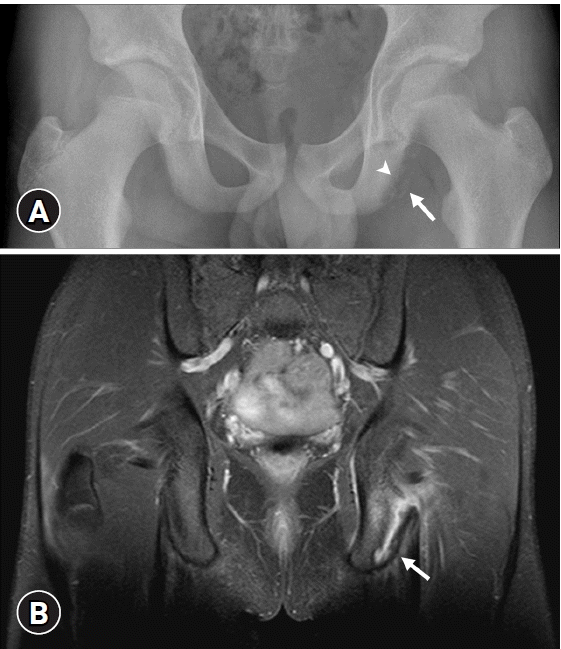 | Fig. 2.Avulsion of the ischial tuberosity in a 16-year-old soccer player with pain for 1 month in the left gluteal region. (A) The anteroposterior radiograph of the pelvis reveals small bone fragments (arrow) around the left ischial tuberosity, which has a cortical irregularity (arrowhead). (B) The coronal T2-weighted magnetic resonance image with fat saturation shows bone marrow edema at the widened apophysis of the left ischial tuberosity (arrow). (C) The longitudinal ultrasonography image of the left ischial tuberosity in the prone position shows the avulsed bone fragments (arrows) at the left ischial tuberosity. Provided by Inje University Busan Paik Hospital. |
2. Anterior superior iliac spine and anterior inferior iliac spine avulsion fractures
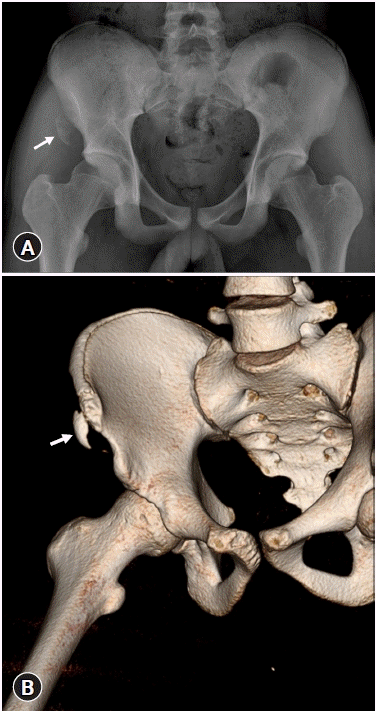 | Fig. 3.Avulsion of the anterior superior iliac spine (ASIS) in a 17-year-old soccer player with pain for 2 weeks in the right hip. (A) The anteroposterior radiograph and (B) the three-dimensional volume-rendered image of the pelvis show an avulsion fracture of the ASIS (arrows). The bone fragment is sharply defined and displaced inferiorly. Provided by Inje University Busan Paik Hospital. |
 | Fig. 4.Avulsion of the anterior inferior iliac spine (AIIS) in a 27-year-old sprinter with pain for 2 days in the right hip. (A) The anteroposterior radiograph of the pelvis and (B) the three-dimensional volume-rendered image show an avulsion fracture of the AIIS (arrows). The bone fragment is sharply defined and displaced inferiorly. (C) The sagittal T2-weighted magnetic resonance image with fat saturation reveals a high signal intensity (arrow) around the proximal rectus femoris tendon (arrowhead) and bone marrow edema of the AIIS (asterisk). Provided by Inje University Busan Paik Hospital. |
3. Iliac crest avulsion fracture
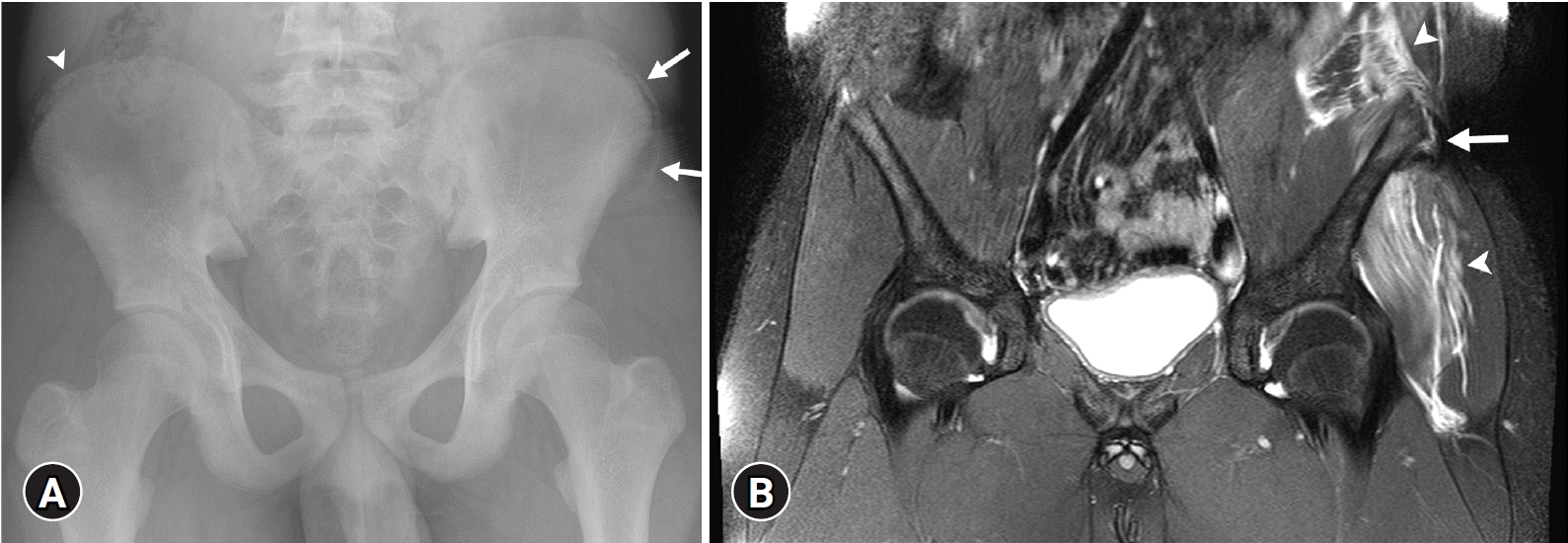 | Fig. 5.Avulsion of the iliac crest in a 15-year-old soccer player with pain in the left buttock for 1 year. (A) The anteroposterior radiograph of the pelvis reveals mild widening of the left iliac apophysis (arrows). Normal fragmentation is seen on the right iliac crest (arrowhead). (B) The coronal T2-weighted magnetic resonance image with fat saturation shows an avulsed apophysis (arrow) and edema at the left abdominis muscles, psoas, and gluteus minimus muscles (arrowheads). Provided by Inje University Busan Paik Hospital. |
4. Pubic symphysis avulsion fracture
5. Femur avulsion fracture
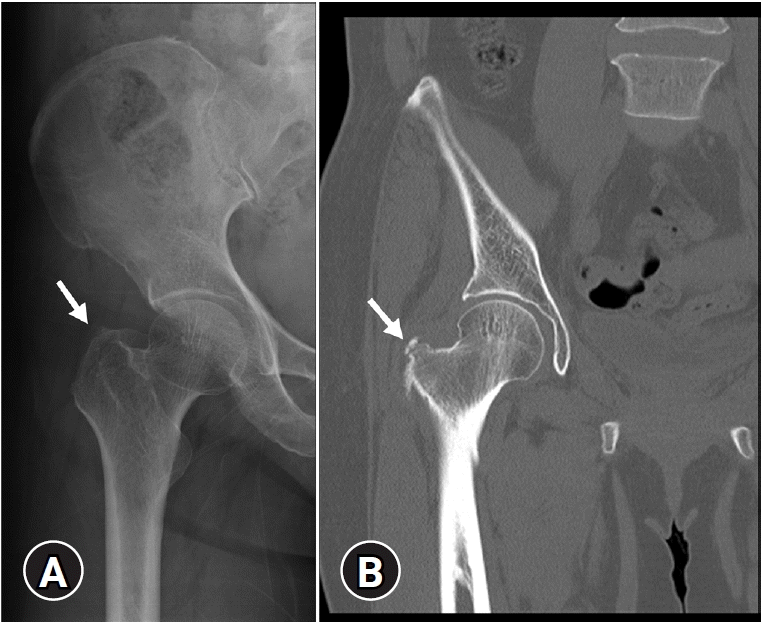 | Fig. 6.Avulsion of the greater trochanter in a 53-year-old woman with pain in the right hip for 1 day after a car accident. (A) The anteroposterior radiograph of the right hip faintly shows a small bone fragment (arrow) around the greater trochanter. (B) The coronal computed tomography image shows an avulsion fracture of the right greater trochanter (arrow) of the femur. The small bone fragment without displacement is well defined. Provided by Inje University Busan Paik Hospital. |
6. Thigh splints
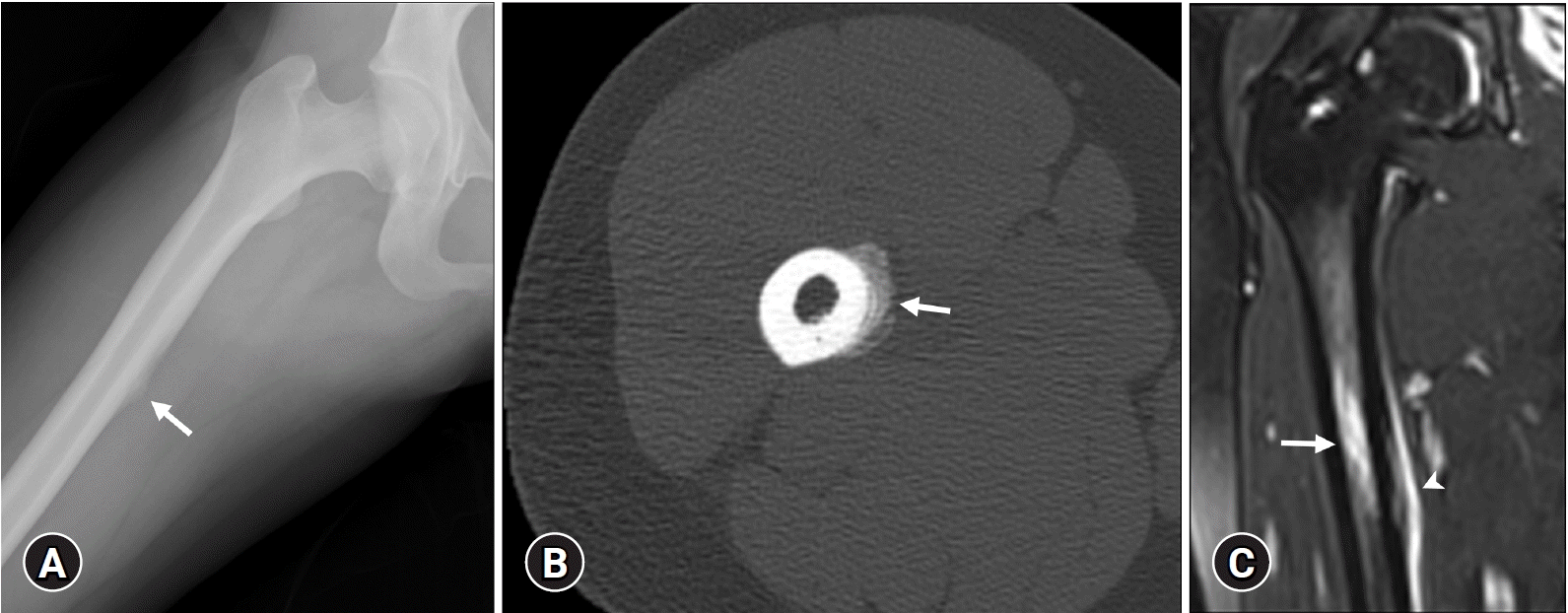 | Fig. 7.Adductor insertion avulsion syndrome in a 19-year-old ballet dancer with pain in the right thigh for 3 weeks. (A) The anteroposterior radiograph and (B) the axial computed tomography image of the femur show periosteal reaction (arrow) at the proximal medial diaphysis of the femur. (C) The coronal T2-weighted magnetic resonance image with fat saturation shows bone marrow edema (arrow) and periosteal reaction (arrowhead) at the medial diaphysis of the proximal femur, which is the attachment site for the adductor longus. Provided by Inje University Busan Paik Hospital. |
Knee avulsion injuries
1. Segond fracture
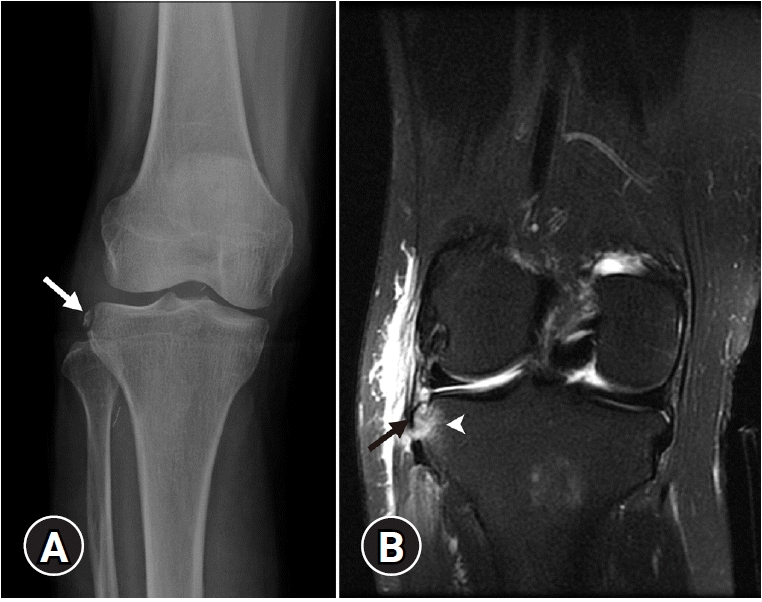 | Fig. 8.A Segond fracture in a 67-year-old woman who sustained a rotational injury to the knee. (A) The anteroposterior radiograph of the knee shows an elliptic bone fragment (arrow) arising from the lateral tibial plateau. (B) The coronal T2-weighted magnetic resonance image with fat saturation shows a tiny bone fragment (arrow), which represents an avulsion of the lateral capsular ligament. Marrow edema along the lateral tibial rim (arrowhead) is also present. Provided by Inje University Busan Paik Hospital. |
2. Anterior cruciate ligament avulsion fracture
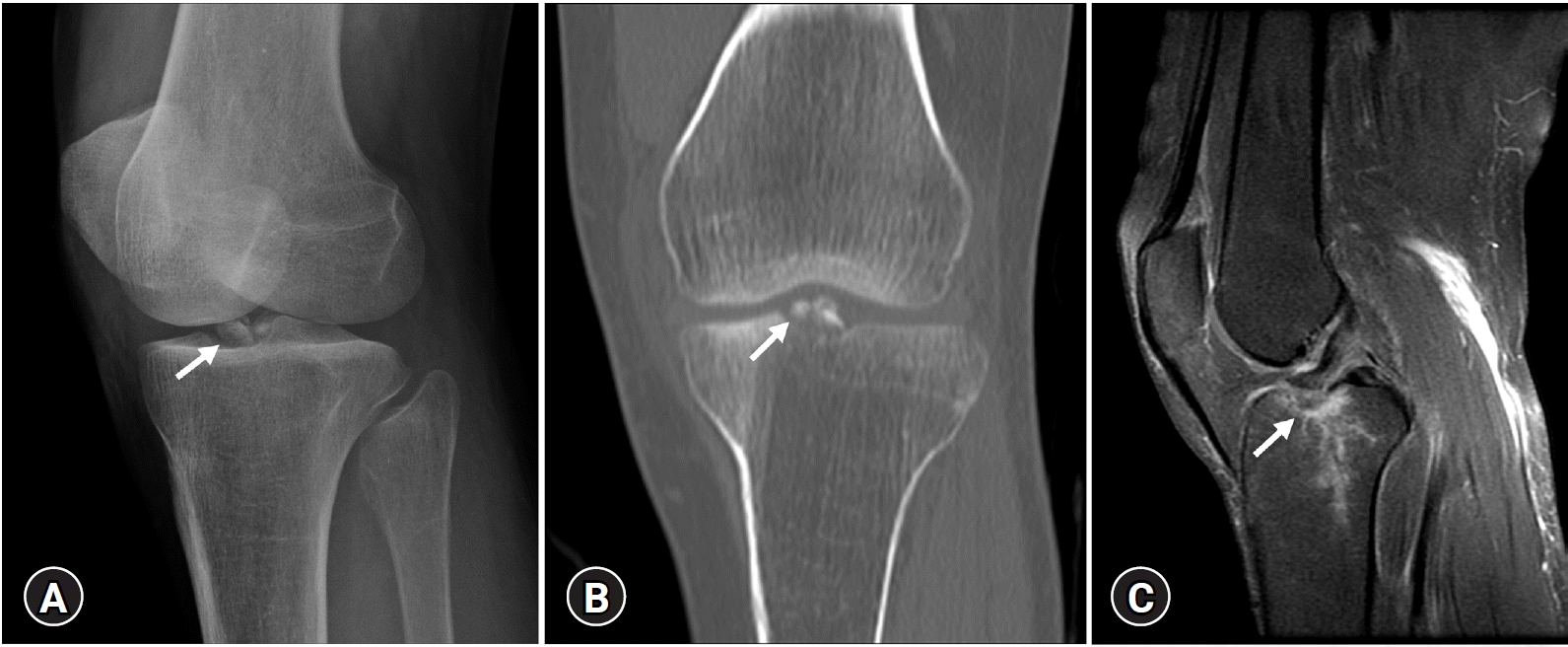 | Fig. 9.Avulsion of the tibial eminence in a 45-year-old woman with acute pain and anterior instability of the knee. (A) The oblique radiograph and (B) the coronal computed tomography image of the knee show a bone fragment (arrow) that arises from the attachment site for the anterior cruciate ligament (ACL). (C) The sagittal fast spin-echo proton density-weighted magnetic resonance image with fat saturation reveals a bone fragment avulsed from the tibia with an intact ACL and adjacent marrow edema (arrow). Provided by Inje University Busan Paik Hospital. |
3. Arcuate complex avulsion fracture
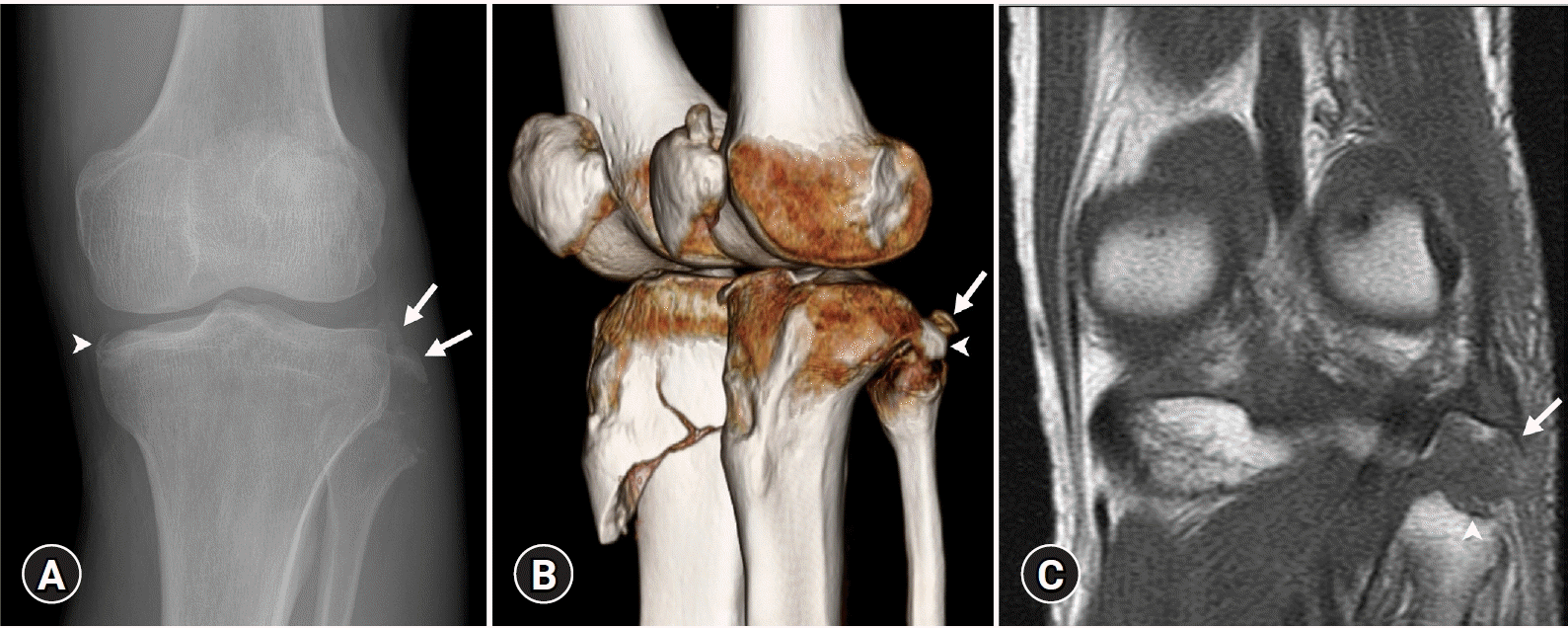 | Fig. 10.Avulsion of the arcuate complex in a 36-year-old man who had a car accident. (A) The anteroposterior radiograph of the knee shows two small bone fragments (arrows) arising from the fibular head. Another elliptic bone fragment (arrowhead) arises from the medial tibial plateau, which represents an avulsion of the deep capsular component of the medial collateral ligament (reverse Segond fracture). (B) The three-dimensional volume-rendered computed tomography image shows two combined avulsion fractures of the arcuate complex (arrow) and the conjoined tendon of the lateral collateral ligament and the long head of the biceps femoris (arrowhead). The right proximal tibia has a fracture. (C) The coronal T1-weighted magnetic resonance image shows the avulsion of the arcuate complex (arrow) from the styloid process of the fibular head (the arcuate sign). Irregularity of the donor site from the fibular head is also seen (arrowhead). Provided by Inje University Busan Paik Hospital. |
4. Iliotibial band avulsion fracture
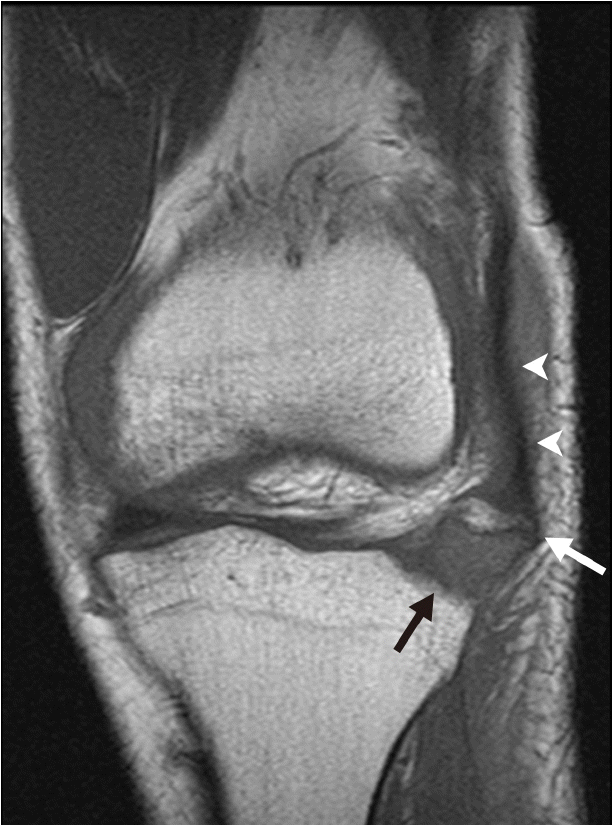 | Fig. 11.Avulsion of the iliotibial band in a 40-year-old man who had a car accident. The coronal T1-weighted magnetic resonance image shows a bone fragment (white arrow) at the anterolateral aspect of the lateral tibial plateau, which is the attachment site for the iliotibial tract (arrowheads). Irregularity of the donor site from the lateral tibial cortex is also seen (black arrow). Provided by Inje University Busan Paik Hospital. |
5. Patellar tendon avulsion fracture
1) Proximal patellar tendon avulsion fracture
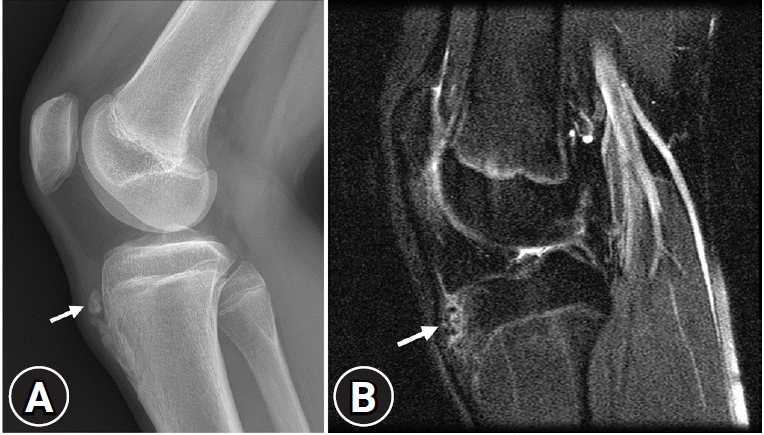 | Fig. 12.Sinding-Larsen-Johansson syndrome in a 10-year-old boy with chronic knee pain. (A) The lateral radiograph of the knee shows a small bone fragment (arrow) at the inferior pole of the patella. (B) The sagittal T2-weighted magnetic resonance image with fat saturation reveals mild edema at the inferior pole of the patella (arrow). Provided by Inje University Busan Paik Hospital. |
2) Distal patellar tendon avulsion fracture
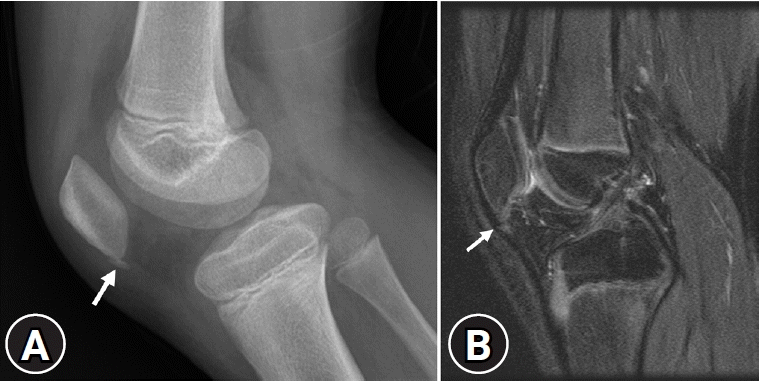 | Fig. 13.Osgood-Schlatter disease in a 12-year-old boy with pain in the anterior knee for 3 years, who had jumped frequently. (A) The lateral radiograph of the knee shows several bone fragments (arrow) adjacent to the tibial tuberosity. (B) The sagittal T2-weighted magnetic resonance image with fat saturation reveals several bone fragments with adjacent edema (arrow) around the tibial tuberosity. Provided by Inje University Busan Paik Hospital. |
Ankle and foot avulsion injuries
1. Fifth metatarsal base avulsion fracture
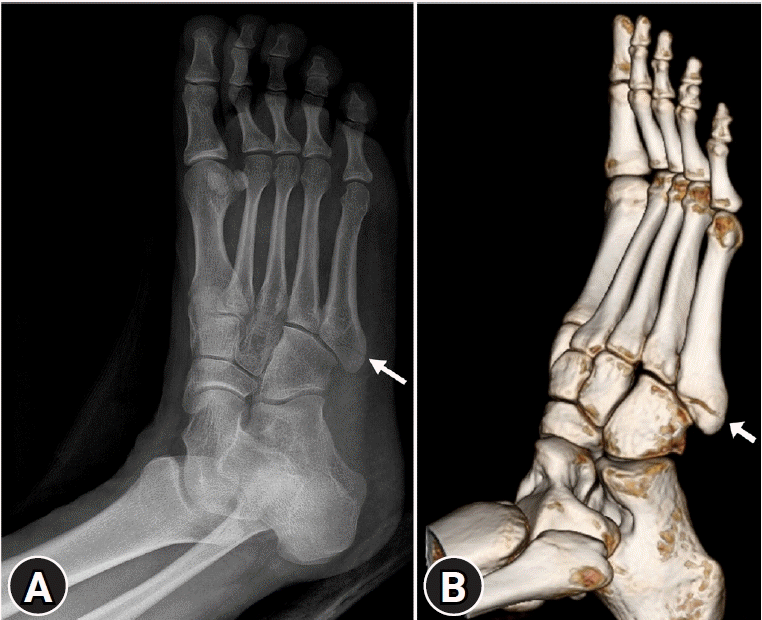 | Fig. 14.Avulsion fracture of the fifth metatarsal base in a 16-year-old girl with midfoot pain for 1 day. (A) The oblique radiograph of the foot and (B) the three-dimensional volume-rendered computed tomography image show a non-displaced avulsion fracture (arrow) at the tuberosity of the fifth metatarsal base. Provided by Inje University Busan Paik Hospital. |
2. Achilles tendon avulsion fracture
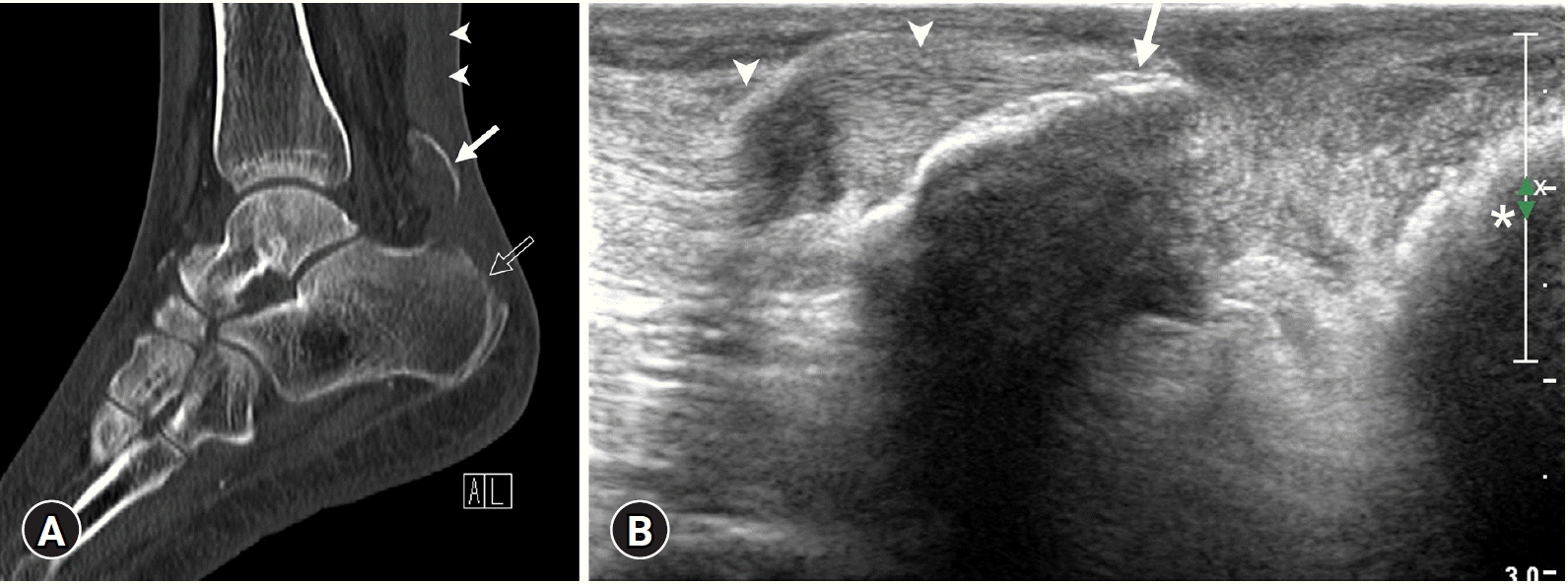 | Fig. 15.Avulsion of the calcaneal tuberosity in a 44-year-old woman with diabetes mellitus. (A) The sagittal computed tomography image of the ankle shows an avulsion fracture of the calcaneal tuberosity (arrow), which is the attachment site of the Achilles tendon (arrowheads). The bone fragment is sharply defined and displaced superiorly. The donor site of the calcaneus is also irregular (open arrow). (B) The longitudinal ultrasonography image of the ankle in the prone position depicts a bone fragment (arrow) arising from the calcaneus (asterisk) with mild cephalad displacement. A retracted Achilles tendon (arrowheads) is also seen. Provided by Inje University Busan Paik Hospital. |
3. Talar anterior capsular avulsion fracture
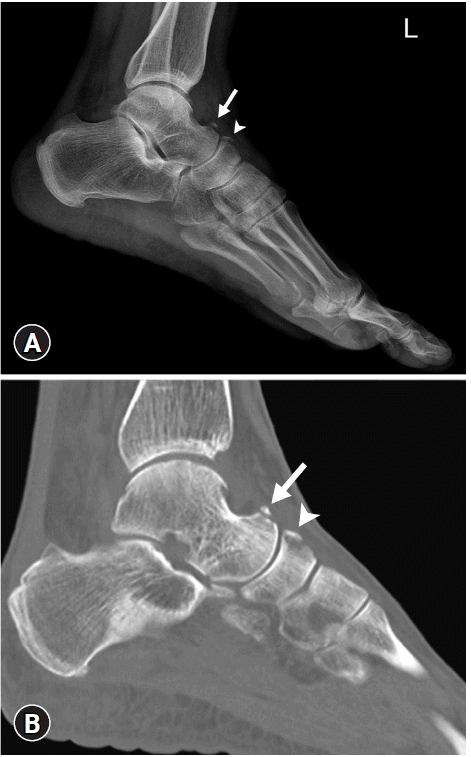 | Fig. 16.Anterior capsular avulsion of the ankle in a 45-year-old man with chronic pain in the proximal anterior foot. (A) The lateral radiograph of the ankle and (B) the sagittal computed tomography image show an elliptic tiny bone fragment (arrow) adjacent to the anterior talus, which is the attachment site of the joint capsule. Another avulsion fracture of the navicular bone (arrowhead) is present where the talonavicular ligament is attached. Provided by Inje University Busan Paik Hospital. |
4. Superior peroneal retinacular avulsion fracture
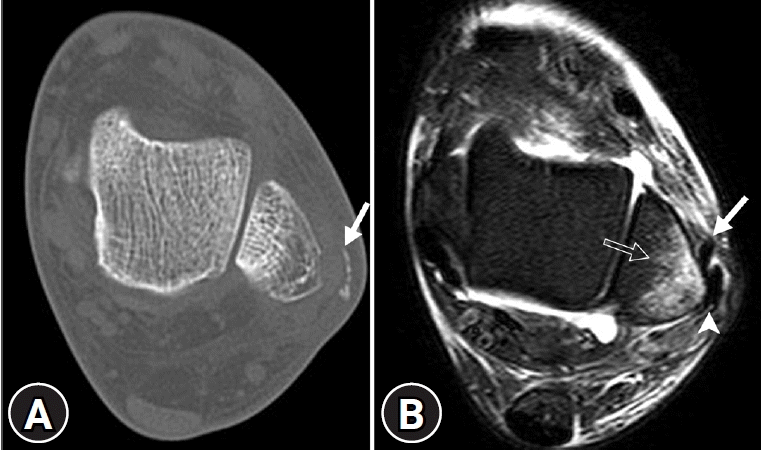 | Fig. 17.Avulsion of the superior peroneal retinaculum in a 27-year-old man with left ankle pain for 3 days, after spraining the ankle during skiing. (A) The axial computed tomography image shows a linear bone fragment (arrow) arising from the lateral margin of the distal fibula. There is soft tissue density between the bone fragment and the lateral malleolus. The normal peroneal tendons are not visible in the retromalleolar groove. (B) The axial T2-weighted magnetic resonance image with fat saturation reveals that the peroneus brevis (arrow) and longus (arrowhead) tendons are lateral to the lateral margin of the fibula, which represents the complete rupture of the superior peroneal retinaculum. Bone marrow edema of the lateral aspect of the distal fibula (open arrow) is also present. Provided by Inje University Busan Paik Hospital. |
Shoulder avulsion injuries
1. Greater tuberosity avulsion fracture
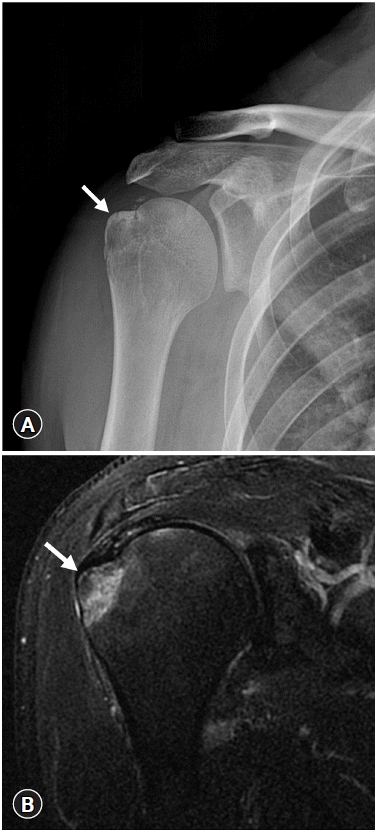 | Fig. 18.An avulsion fracture of the greater tuberosity in a 30-year-old man who experienced shoulder pain after falling. (A) The anteroposterior radiograph of the shoulder shows an avulsion fracture of the greater tuberosity (arrow). (B) The coronal T2-weighted magnetic resonance image with fat saturation reveals marrow edema of the greater tuberosity (arrow). The rotator cuff is intact. Provided by Inje University Busan Paik Hospital. |
2. Lesser tuberosity avulsion fracture
Elbow avulsion injuries
1. Little Leaguer’s elbow
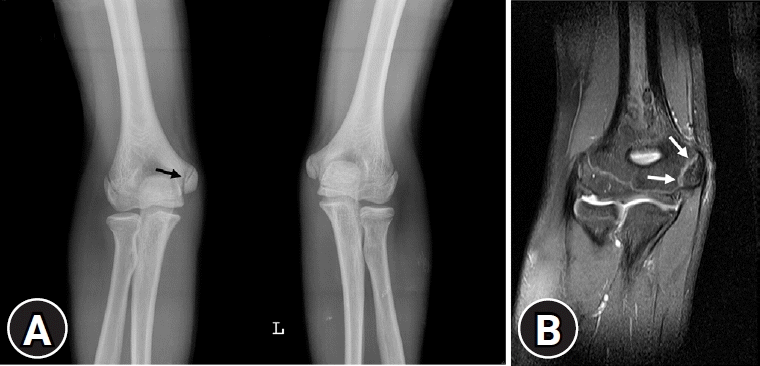 | Fig. 20.Little League elbow in a 14-year-old baseball pitcher with elbow pain for 3 months. (A) The anteroposterior radiograph of both elbows shows a mild widening of the medial epicondylar physis (arrow). (B) The coronal T2-weighted magnetic resonance image with fat saturation shows widening of the medial epicondylar physis, which is surrounded by increased T2 signal intensity due to edema (arrows). Provided by Inje University Busan Paik Hospital. |
2. Olecranon process avulsion fracture
3. Medial epicondyle avulsion fracture
Hand avulsion injuries
1. Volar plate avulsion fracture
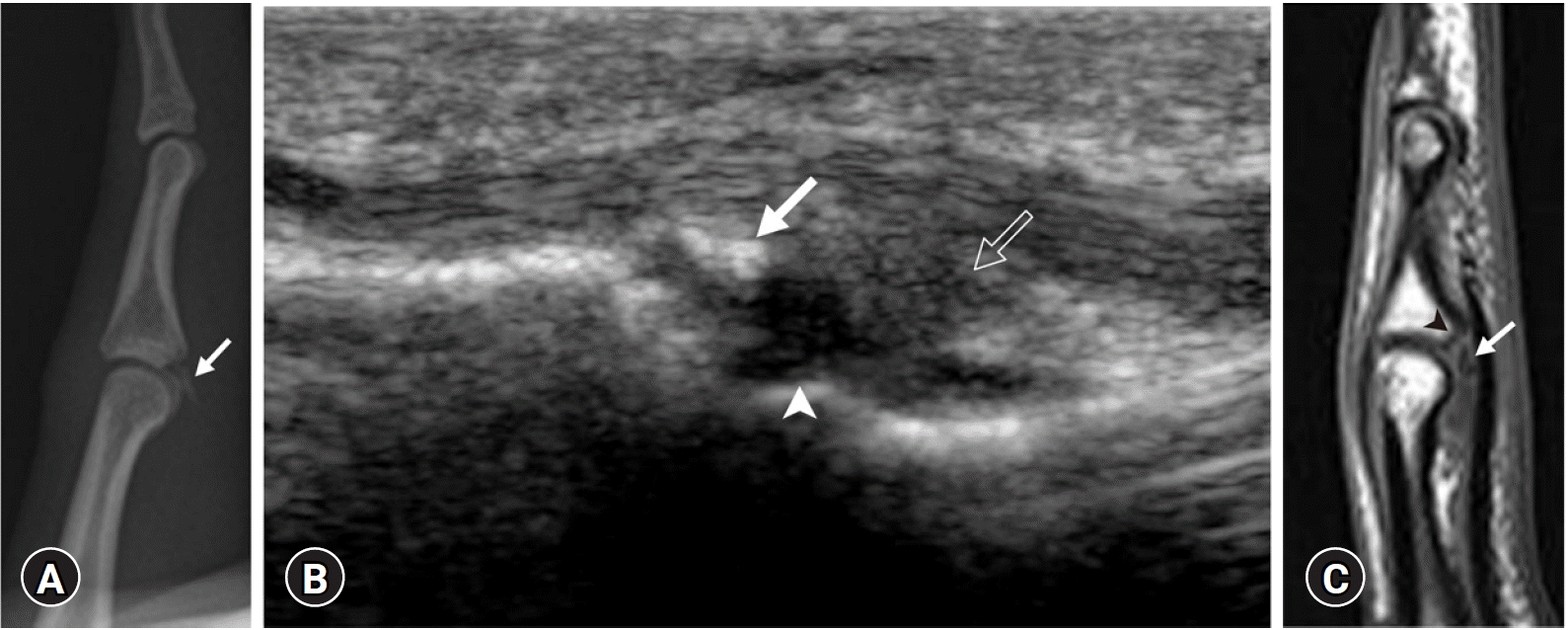 | Fig. 22.An avulsion fracture of the volar plate in a 20-year-old handball player with acute pain in the second finger after a hyperextension injury. (A) The lateral radiograph of the second finger shows a small bone fragment (arrow) arising from the volar aspect of the base of the middle phalanx. (B) The longitudinal ultrasonography image shows a small bone fragment (arrow) and adjacent fluid collection (arrowhead) at the volar aspect of the base of the middle phalanx. The volar plate is deformed and it has low echogenicity (open arrow). (C) The sagittal T1-weighted magnetic resonance image shows an avulsion fracture of the volar plate (arrow). Irregularity of the donor site from the base of the middle phalanx is also seen (arrowhead). Provided by Inje University Busan Paik Hospital. |
2. Skier’s thumb
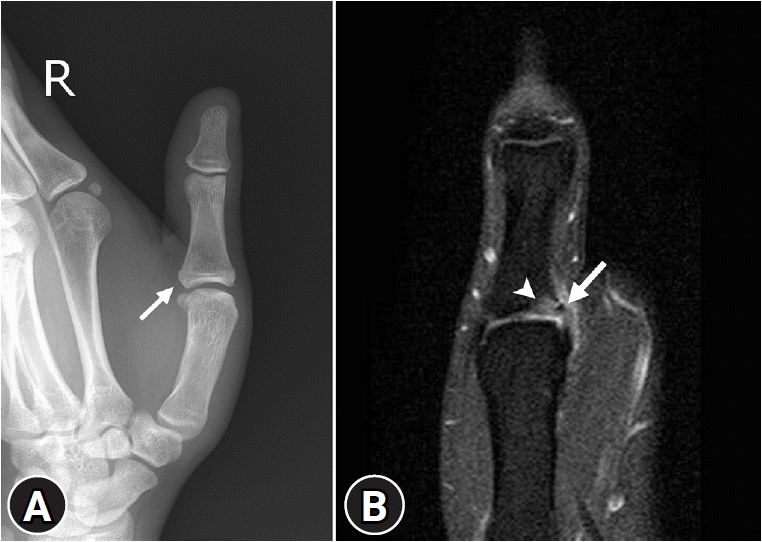 | Fig. 23.Skier’s thumb in a 19-year-old skier with acute pain in the thumb. (A) The anteroposterior radiograph of the thumb shows a tiny bone fragment adjacent to the base of the proximal phalanx. (B) The coronal contrast-enhanced T1-weighted magnetic resonance image shows an avulsion fracture of the distal ulnar collateral ligament (arrow) with adjacent marrow edema (arrowhead). Provided by Inje University Busan Paik Hospital. |
3. Mallet finger
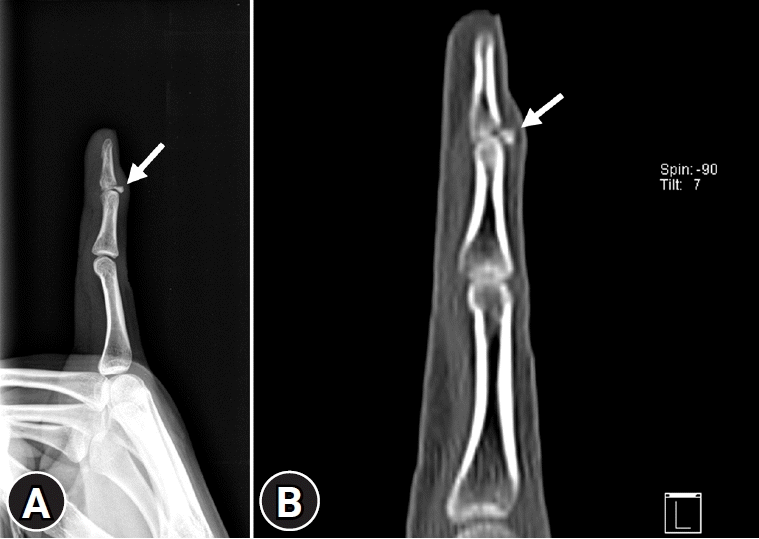 | Fig. 24.Mallet finger in a 26-year-old basketball player with acute pain in the fifth finger. (A) The lateral radiograph of the fifth finger and (B) the sagittal computed tomography image show a triangular bone fragment (arrow) at the extensor aspect of the distal phalanx that is adjacent to the distal interphalangeal joint. Provided by Inje University Busan Paik Hospital. |




 PDF
PDF Citation
Citation Print
Print



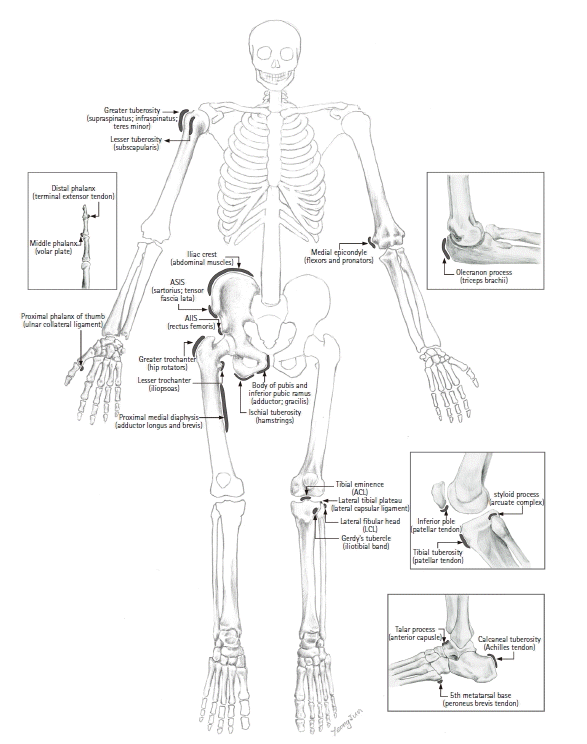
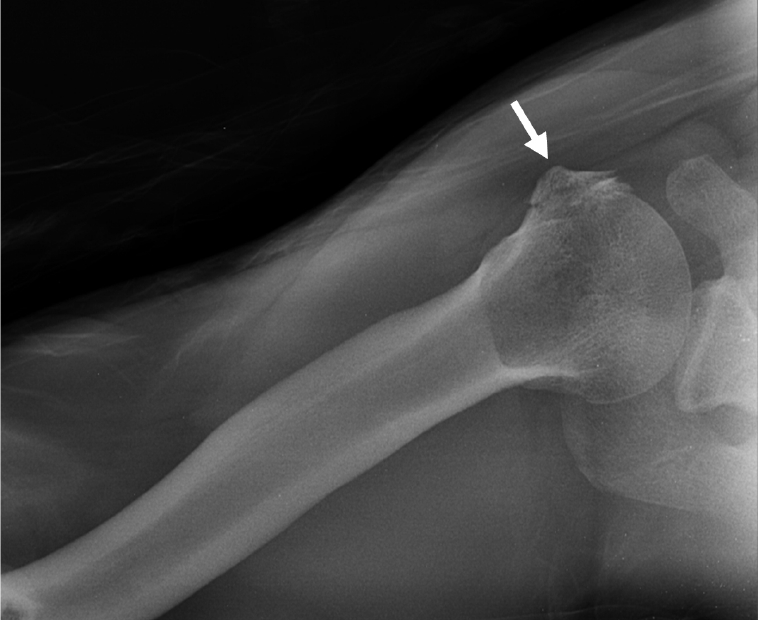
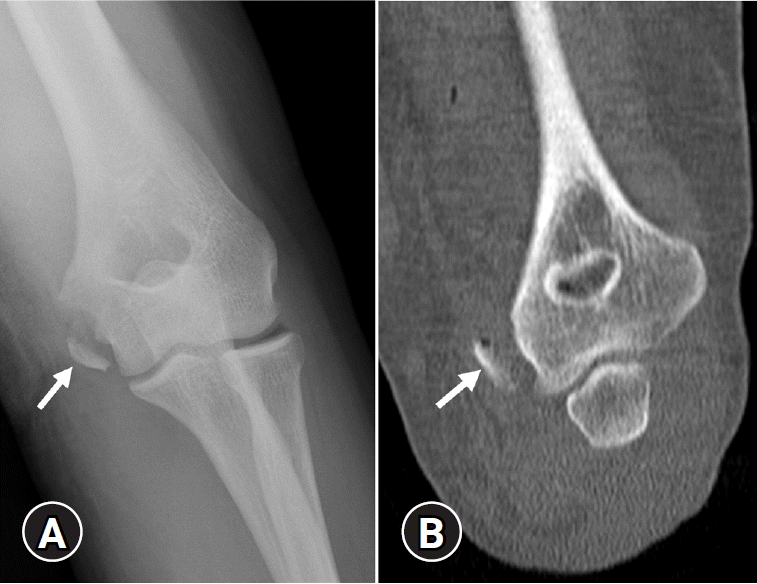
 XML Download
XML Download